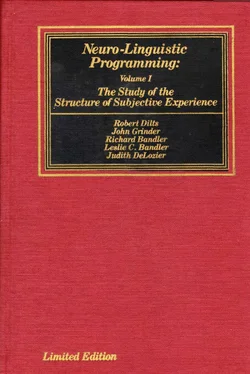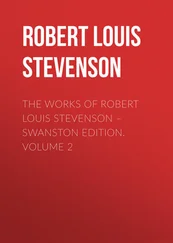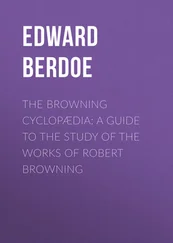S: (Eyes shift up then down left. Breathing shallows. Eyes shift back up then down and to the right. Scrunches left side of face slightly, sighs slightly, looks back up and then down and left and starts to shake her head slightly back and forth) … I … well … I'm sort of confused … It's like I'm trying to take that one (Indicates left shoulder) and put it together with this one, but I … it's very intense …
A: Jan had begun the process of what we call "integrating 4–tuples." By firing off the two anchors at the same time, or "collapsing" the anchors as we say in NLP, I actually forced the two different representations, or 4–tuples, into the same time time and space, neurologically. This forces the creation of a new 4–tuple that is a combination or integration of the two that are going together. In this way you add resources to the problem state… . My guess is, judging from Jan's response to what I just did, that in this case the resources from the experience anchored over here (gestures to left shoulder) were not enough to help Jan resolve what was going on over there (Gestures to right shoulder). That's not at all surprising since they were just two experiences that I picked out, and the resources weren't tailored for the problematic state … and I'll show you how to do that in a minute …
What I wanted to demonstrate by collapsing these two anchors is the impact it can have. Could everyone tell there was something going on? … It was obvious to me through her changes in breathing, the asymmetry of her face, all of those eye movements, and so on, that Jan was doing a lot of internal processing. Most of it was probably going on at the unconscious level. Consciously, Jan experienced "confusion," which is very common when you are integrating experiences, by the way. She knew the two experiences were going together in some way … but at the end she shook her head, giving me the indication that she needed more resources to make a satisfactory integration … Now Jan, you would like to have more choices about that
experience (Gestures toward right shoulder) wouldn't you?
S: Oh yes. It's really frustrating.
A: [To Audience] Up until now none of you have known anything verbally about this experience (Gestures to right shoulder) but I'll bet most of you could guess that it was frustrating for Jan. (Agreement from the audience.)
A: In order for me to help Jan get more choices about this situation I don't even need to know anything verbally about the situation, as long as I have access to sensory experience. In NLP we call working in this way – that is, without content — "secret therapy." A lot of times people are shy, nervous or resistant about giving out the details of a problem, or they literally can't put the details into words, or they don't even consciously know them. Because we work with form in neurolinguistic programming, we can get around all that because in most situations we're not concerned with the content details … Now I'll continue working in this way with Jan to show you how it can be done. So what I want to do, to make the demonstration a little easier to follow, is to give this frustrating experience some innocuous, non–referring name … like some color, for instance … What color would you like to name this experience, Jan?
S: Umm … Yellow.
A: Okay, when Jan 'yellows' (Squeezes right shoulder) then, her breathing, facial expression, skin color and so on change to what she is doing right now … 'Yellow,' of course, is another verbal anchor for this experience. I've just now paired it with the other anchors we have established for it. Jan, what color would you like to call your resources?
S: Blue.
A: 'Blue.' All right, we'll call your resources 'blue'… Now I'd like to show you how to find, at the formal level, the resources Jan needs to get more choices about 'yellowing.' The first thing I want to do is find out what state of consciousness she's in when she's 'yellow'. And the way I'm going to do this is to simply ask her which representational systems she has access to in this state … I already have some information about which representational systems she's using. What is it?
Woman: Her accessing cues?
A: Yes, very good. When Jan is 'yellowing' her eyes are down and left which is … ?
Man: Internal dialogue.
A: Right,… internal dialogue … good. There is something else. You'll remember that she sighs slightly —breathing from the abdomen — and that she mentioned something about feelings. So I can also bet that there are some kinesthetics involved … But let's check this out with Jan …Jan, what I want you to do is to put yourself back into an actual situation when you were 'yellow.' And I'm going to ask you some questions about it, okay?
S: Okay.
A: When you're 'yellow' how easy is it for you to see what's going on around you externally?
S: Ah … (Looks up and left) not very … I could see things if I wanted to, I guess, but I don't look at things very much while it's going on.
A: (Squeezes S's right shoulder) Okay … How about internally? Do you use your mind's eye, or make pictures in your head when you are 'yellow'?
S: Ah … (Looks up and left, then down and right) … No.
A: (Squeezes S's right shoulder) All right … How well can you hear what's going around you externally when you are 'yellow'. Do you hear what other people are saying and what their tones of voice are like?
S: (Looks down and left then up) … Uhmm …
A: (Laughs) You won't find it up there … it's over here (Guides S's eyes straight and to the left) … [To audience] One of the things I'm doing is watching Jan's accessing cues to make sure that she's accessing and checking out the appropriate representational system, so I can be sure her response is congruent and valid. A lot of times people make pictures, hear voices or get feelings that are out of consciousness for them. So you have to check it out with their less conscious nonverbal forms of communication … You have probably also noticed that I've been reanchoring her as she gives each response. This helps to reinforce the anchor … Come up with an answer yet, Jan?
S: Well … I can hear some things when I listen for them … but in general not very much.
A: (Squeezes S's right shoulder) OK … How about inside your head? Is there a lot of noise going in there when you are 'yellow'? Do you talk to yourself a lot?
S: (Eyes move down and left. Starts nodding her head) … Oh yes … a lot of it .. . I'm saying all kinds of things.
A: (Squeezes S's right shoulder) Aha … Okay, let's move to kinesthetics. Do you have much external tactile body awareness? Like temperature, texture, pressure and so on?
S: (Eyes up and then down and right) Mmmm, no … not at all. That's interesting.
A: (Squeezes S's right shoulder) … How about internal feelings?
S: (Eyes down left and then down right) Oh yes, a lot of those (Voice very low. Begins to tense up. S grips left hand very tightly). I get so frustrated … I… (Lips tighten, clenches jaw.)
A: (Squeezes S's right shoulder) All right … come back … no need to access that too much … How about smells or tastes? Are you aware of any of those?
S: UhUh … none.
A: (Squeezes S's shoulder) … Any internal, remembered smells or tastes?
S: (Eyes down and left) No.
A: (Squeezes S's right shoulder) … OK … [To audience] Now I've got an explicit description of Jan's state of consciousness that we're calling 'yellow'. I'll map it out visually on the blackboard so you can all see what's going on … (Writes the following on the blackboard.)
'YELLOW'
V e—?
V 1—0
A e— ?
A i— X
K e— O
K i— X
O — O
A: "X's" mean full access to the representational system. 'O's' mean no access, or negligible access to the representational system. And question marks mean partial or questionable access … What this diagram indicates to me is that Jan is losing access to a lot of potential resources when she's yellow because all of these systems drop out — notably her visual system but also practically all systems involved in gathering information from external sources. Her internal dialogue and internal feelings override all of the other representational systems …
Читать дальше











